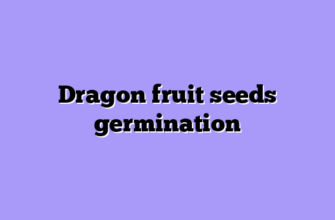Today we will talk about the last of the famous Asunta varieties, which received the fifth order number.
Description
This variety, which many of you know as “Asunta 5 Edgar,” now has an official name: “Sunset Sherbet.” There is already an official Asunta 5, which we call “Asunta 5 Paco”, “La Palma” or “Kevin”. To stop people from getting confused, it has been given a new name.
Most likely, this confusion is caused by the fact that from harvest to harvest the color of the skin may vary slightly. For example, last year we had them slightly yellowish, but this year there is no trace of yellowishness and it’s dark brown.
| Origin: | California |
| Peel color: | Yellowish-orange |
| Flesh color: | Pink |
| Brix: | ~18-19 |
| Pollination: | Requires Cross-Pollination |
| Taste: | Very sweet, little tart |
| Days until harvest: | 49-53 days |
| Fruit production: | 4 out of 5 |
| Flavor: | 4 out of 5 |
| Commercial planting: | 4 out of 5 |
The outside of this beautiful, rare dragonfruit is yellowish-orange, and the inside is light pink to deep fuchsia.
It tastes like red pitaya, but it can sometimes be a bit sweeter. Fruits vary in how sweet they are. However, it’s not as sweet as regular yellow dragonfruit.
Pitahaya is ready to eat as soon as it’s picked. Right away, eat them or put them in the fridge.
Do Asunta 6 and 24 exist ?
Yes, No. 6 really exists. What can’t be said about number 24. I assume that this number is taken from one of the fruits that had a brix score of as much as 24!
Naturally, such a one-time result, with no possibility of repetition, means nothing. So there are still six of them. By the way, quite often I hear the idea that the variety Chameleon and Asunta 24 are one and the same. This, too, is obviously a mistake. Why? Because there is no variety with this number, but there is Chameleon. The description that we found for the alleged variety #24 does not match what “Chameleon” sort really is.
My Adventures with the Asunta 5 Dragon Fruit
For years, my dragon fruit farm has been a canvas of vibrant colors – the fiery fuchsia of the Red Hylocereus, the cool, emerald green of the Selenimerick, and the classic white flesh of the Crystal. But last season, I decided to add a new jewel to my crown: the enigmatic Asunta 5.
Now, let me tell you, this dragon fruit isn’t your average Joe. Unlike its red cousins with their spiky, intimidating exteriors, the Asunta 5 boasts a smooth, yellowish-orange peel that almost glows in the sunlight. It’s like a sunrise captured in a fruit, a complete departure from the usual dragon fruit aesthetic. But the real magic lies within. Crack it open, and you’re greeted by a sight that stops you in your tracks – flesh the color of a delicate pink pearl. It’s a beauty that compels you to take a bite, and that’s where things get truly interesting.
The first thing that hits you is the sweetness. It’s not the sugary punch of some fruits, but a gentle melody that lingers on your tongue. Imagine the sweet, juicy flesh of a honeydew melon infused with the subtle floral notes of a rose. That’s the Asunta 5 for you. It’s a symphony of flavors that’s both familiar and surprising, like encountering an old friend in a new outfit.

Here’s the thing, though: the extra effort is absolutely worth it. The Asunta 5 is a resilient grower once it’s established. Its climbing vines, adorned with vibrant green leaves, weave a tapestry of life on the trellis. And then, the moment you’ve been waiting for arrives – the first bloom. It’s a breathtaking sight, a large, white flower that unfurls its petals under the cloak of darkness, releasing a sweet fragrance that attracts night pollinators. Witnessing this nocturnal dance of nature is a reward in itself.
The harvest, when it finally comes, is a celebration. Each Asunta 5 fruit feels like a little treasure you’ve unearthed. And let me tell you, these beauties are conversation starters at farmers’ markets. The vibrant color combination and the intrigue of the pink flesh draw customers in like moths to a flame.
Now, I wouldn’t be a true farmer if I didn’t experiment. This year, I’m planning on incorporating the Asunta 5 into some of my recipes. Think dragon fruit salsa with a twist, or maybe even a refreshing pink pearl smoothie. The possibilities are endless, and that’s the beauty of this unique fruit.
The Asunta 5 has taught me a valuable lesson: sometimes, the most rewarding things in life require a little extra TLC. It may be a bit more challenging to grow, but the payoff – in terms of taste, beauty, and the sheer joy of discovery – is more than worth it. So, if you’re looking for a dragon fruit that’s more than just a pretty face, give the Asunta 5 a try. You might just discover your new favorite fruit, the pink pearl that will steal your heart (and taste buds).

Conclusion
One of the newest things made. Not self Fertile. Need to pollinate each other. Can use pollen from Tricia or from another plant. Nice flowers that are bright purple.
The name Sunset Sherbet was a great fit for this variety because its skin was the color of the sun setting and its flesh tasted like fruity sherbet. Really a DF cultivar that tastes great and will soon be loved by everyone who tries it.








